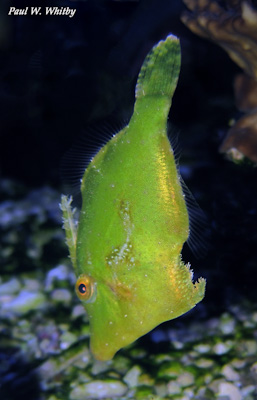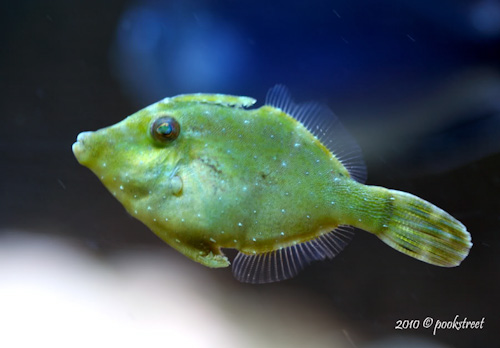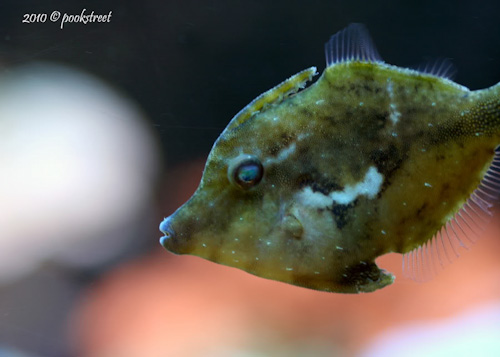 Fish Profile
Fish Profile
Fish Profile
Aiptasia Eating Filefish, Acreichthys tomentosus
|
 |
 |
 |
| Common Name: |
Aiptasia Eating Filefish, Bristletail Filefish, Matted Filefish, Matted Leatherjacket |
| Scientific Name: |
Acreichthys tomentosus |
| Size: | Maximally 5-6 inches, A. tomentous are commonly sold in the 2 inch range. |
| Distinguishing Features: |
Coloration can vary and be almost any shade from a very pale green through a dark mottled brown. The pigment is distributed over the body in a camouflage pattern allowing them to effectively blend in with algaes. They are reported to be able to change color/shade to blend in to their environment. They are thin with an elongated dorsal fin, much like a triggerfish. |
| Distribution: |
Found throughout the Indopacific region to East Africa, as far north as Ryukyu Islands, and as south as New South Wales (Australia). |
| Natural Habitat: |
A. tomentosus is a reef inhabitant where it hunts prey among the coral/rock formations. It is most frequently found on the reef edge and over areas of rubble in shallow water. Its markings help camouflage it in potentially algae covered environments. |
| Feeding Requirements: |
Having kept many of these fish, my number one food recommendation would be mysis shrimp. These evoke a strong feeding response from this fish. Once established I have seen them eat everything offered from small pellet to flake foods. Like all fish, variety is the key to success and I would recommend a healthy diet of small chopped meaty foods such as shrimp, krill, mysis, squid, etc. Take into account the small mouth size when preparing such foods. |
| Difficulty Rating: (1 = easy - 5 = hard) |
Easy to keep so long as the fish is eating at the time of purchase. Care should be taken when introducing to a heavily stocked aquarium as other fish may see this camouflaged filefish as a piece of algae, and try to nip it. Once they are acclimated, they seem to do very well. My experience lead me to a rating of "2". |
| Aggressiveness Rating: (1 = shy - 5 = nasty) |
This fish appear to be very non-aggressive and is actually somewhat shy in the marine aquarium. I have heard of aggression between other members of the same species, but have also successfully housed several specimens at once. However, I have not tried introducing a second specimen to a tank with an established adult. My experience leads me to a rating of "1". |
| Captive Requirements: |
Apart from a varied diet, the filefish really has no special requirements. |
| Reef Tank Compatibility: |
In my experience, I have had no issues with compatibility, however A. tomentosus will eat pods in the aquarium and may reduce the local population below that able to sustain a healthy Mandarinfish. Another fact the potential owner should be aware of is that there are several reports of these fish nipping on other things in the tank besides aptasia. I have seen rare occurrences of zoanthids, LPS, fan worms, yellow polyps and other small sessile invertebrates being nipped. While none of these seem to be a major food source, the filefish does appear to be an opportunistic feeder at times. This may be further compounded by several misidentified fish reaching the aquarium trade. Similar fish from Florida and the Caribbean have been misidentified as A. tomentosus and are more likely to nip corals. Of all the corals/invertebrates that A. tomentosus has been known to pick on, the one I have seen it predate multiple times are bristle worms. Without a doubt, these small fish will actively reduce the bristle worm population. |
| Personal Experience: |
Above, I have mentioned a few aspects of my experience with these fish. I have seen at least a dozen in various tanks, my own and those of friends. In my mind, they are hardy, easy to keep and very shy. They are not the most beautiful of fish, though they do have a certain charm and are distinctly different from the common fish we see housed in most aquaria. They do not require lots of space, though lots of live rock certainly helps keep them healthy. While these little fish appear to be very fragile and seem to float along with the tank flow, they can be powerful swimmers and will shoot across a tank if disturbed. Often times they are seen standing on their noses, looking almost like a blade of a sea grass. In all the tanks I have seen them in; they were added to control the aiptasia problem. On addition, A. tomentosus does not appear to be at all interested in aiptasia. It is not uncommon for 2 weeks to go by with absolutely nothing but complete disregard for the pest anemones. Then, for no apparent reason the fish begins to devour them. Inside a few days there is a marked decrease in aiptasia and over a week or so, most are gone. This delay between adding and beginning to eat the aiptasia seems fairly common. The only time I have not seen this is when transferring a tank acclimated (and aiptasia eating) filefish. In this case they seem to begin munching straight away. Interestingly, the filefish also seems to like pest majanos and will readily consume these as well. One caveat, not every filefish will eat aiptasia. From what I've seen there is about a 10% fail rate in this. For some reason there are a few fish that seem to completely ignore aiptasia, but live quite happily in the aquaria. |
| Summary: |
The Aiptasia eating filefish lives up to its name, but care should be exercised when introducing one to a tank heavily stocked with xenia, mushrooms, or polyps. While not all will nip at corals, some do. |
| Futher Reading: |
There are a number of threads on ReefCentral that carry useful information for a potential owner: http://www.reefcentral.com/forums/showthread.php?t=1789369 http://www.reefcentral.com/forums/showthread.php?t=1924047 http://www.reefcentral.com/forums/showthread.php?t=1795899 |
Note: All of the above information has been compiled from various sources and should be used as a guideline, not a hardfast rule. Use caution when selecting animals for your own tank and research as much as possible before purchasing any animals. Remember that certain corals and fish are very hard to keep if their special requirements are not met. The information contained here is to help you make an informed decision. The author assumes no responsibility for any consequences that may arise from the use of this information.


